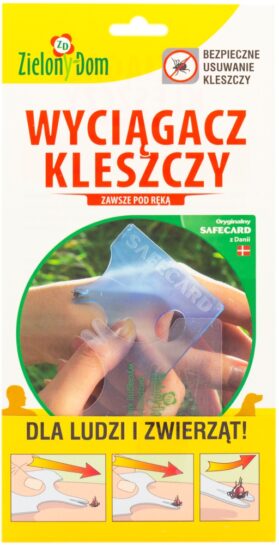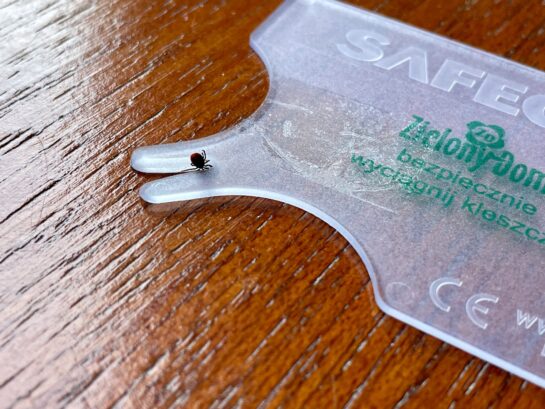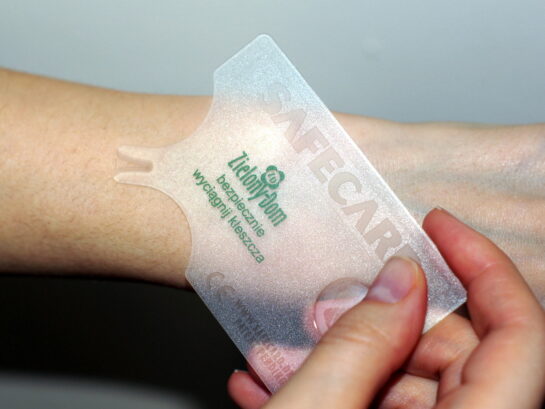Tick remover
SafeCard tick remover was developed in collaboration with scientists, biologists and medical doctors – specialists in tick-borne diseases. Due to specific shape of the SafeCard, tick removal can be performed on any part of the body. The card has a second smaller cutout, which allows the user to remove bee and wasp stingers from the skin.
The SafeCard was designed to pluck the parasite from the skin without using force. Removing the tick is extremely easy. A slow, smooth movement with a specially shaped card pulls it out of the body. Consequently, oftentimes the user avoids infection with dangerous bacteria or viruses.
The SafeCard is the same size and shape as a traditional credit card, making it easy to keep it in your wallet and use it whenever necessary.
What should you know about ticks?
What is a tick?
More than 800 species of ticks live all around the world. Adults reach a maximum size of 4 to 7 millimeters and live in various stages of development for 2 – 3 years. The tick is an arachnid of the mite superorder Parasitiformes. Their lifestyle as a feeding on the blood parasite makes it a very dangerous vector of disease.
Where does the tick live?
Ticks live primarily on the outskirts of forests, in clearings, by streams, in tall grasses and bushes – here it encounters wild animals like foxes, mice, deer or birds. It also does well in allotments, gazebos, parking lots and playgrounds transported in by the hedgehogs, squirrels or ants. Ticks do not fall from trees, as is commonly believed, but live near the ground. The tick species are widely distributed around the world, from Europe, through parts of North America to Asia.
When are ticks active?
Ticks become active when temperature reaches 7 degrees Celsius. In Poland, they are active from spring to late autumn, and when the winter is very mild up until January. They like warmth and humidity, so they are very active on rainy summer days. Ticks live up to three years. Because they can go months without feeding, some live up to five years. Ticks have virtually no natural enemies, excluding some species of birds and roundworms.
How to protect yourself from tick bites?
You cannot protect yourself completely from tick bites, but you can reduce the risk by following certain rules: do not walk in tall grasses or bushes, when on walks in the woods or on hikes always wear long-sleeved shirts, long pants with socks, sandals only with knee socks, choose light-colored clothes (ticks can be seen better and can be removed before they bite), check the whole body regularly for ticks, this applies especially to children, dogs and cats.
Which places on the body do ticks choose?
Ticks can walk for many hours on the human body before finding a warm, preferably also moist place with thin skin. In humans, these include, armpits, navel, groin area and scalp. Ticks usually drink blood for two to three days and then fall off.
What to do when a tick bites us?
When a tick bite occurs, remove the parasite as soon as possible. When removing the tick, you must be careful not to damage it, so as not to allow, accidentally, the secretion from its intestines get into the wound. Do not use oil, butter, glue, fingernails, tweezers or clippers. It is best to use SafeCard – the practical tick extractor in the form of a credit card. With the help of this item, you can remove the tick by a sliding motion simply and securely. SafeCard (credit card sized) can be always carried with you.
Why are ticks dangerous?
Ticks can transmit dangerous diseases. The most well-known infections are Lyme disease and tick-borne meningitis. General symptoms like headaches, fatigue, fever or other flu-like symptoms can be caused by a tick bite. These symptoms can appear even three weeks after the bite. Often, but not always, there is redness around the bite. Should you observe any of those symptoms, seek medical advice.
EAN 5900026003557
Fertilizers and plant care products since 1991.


